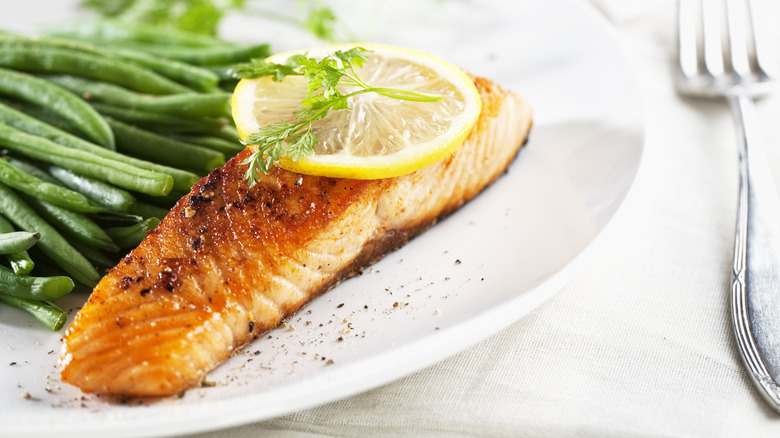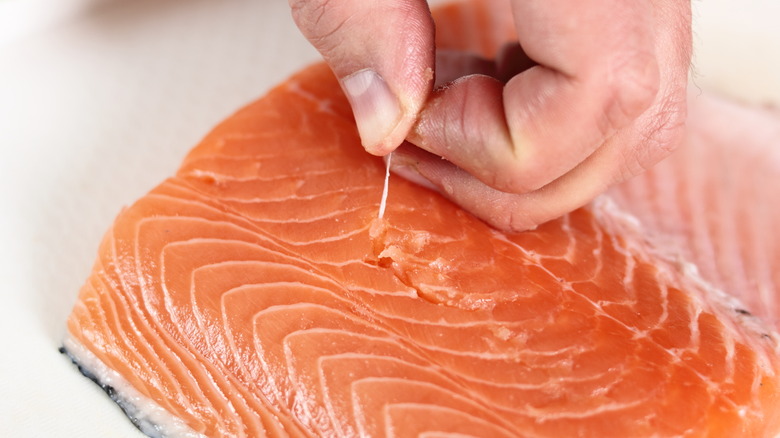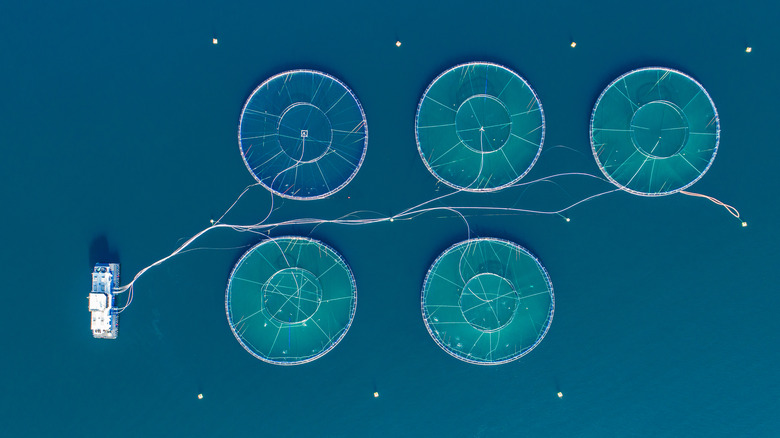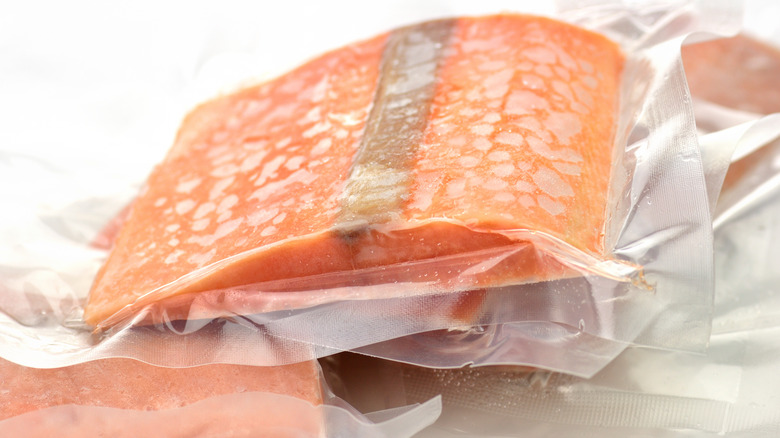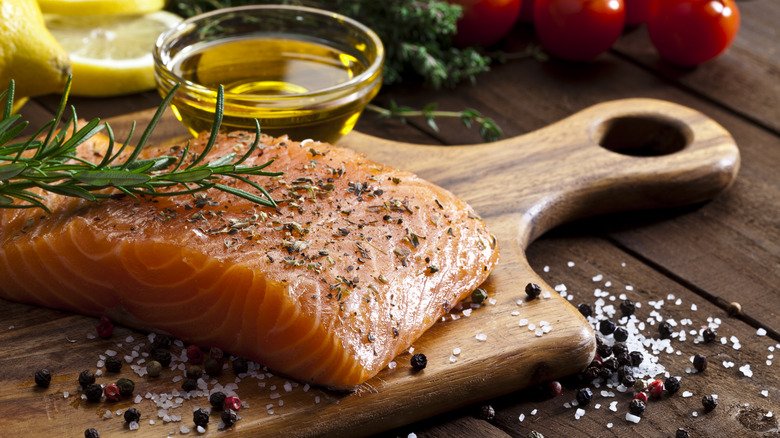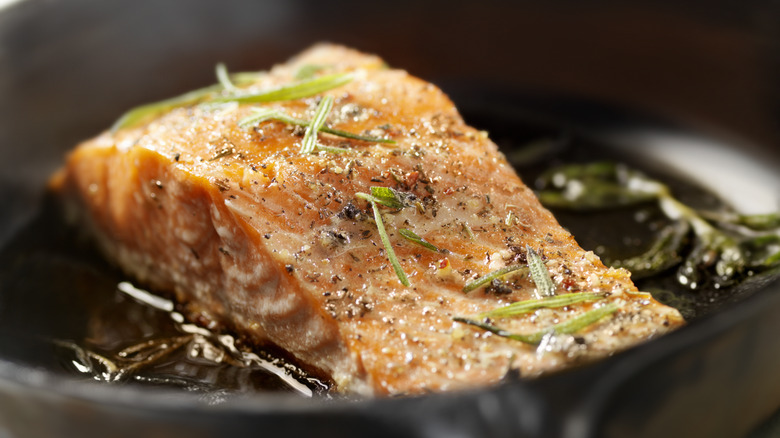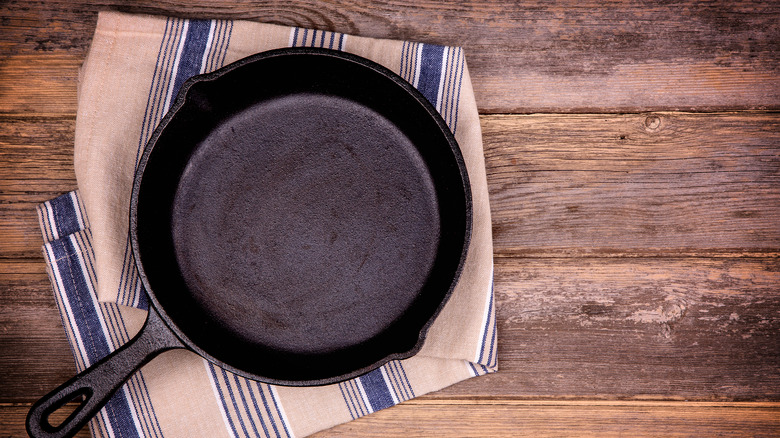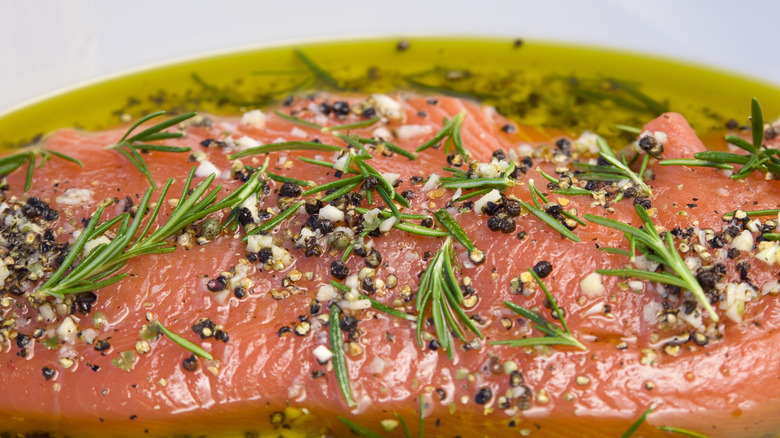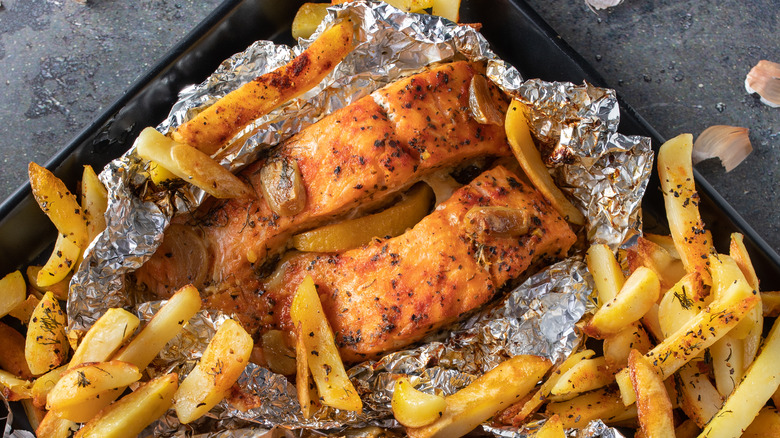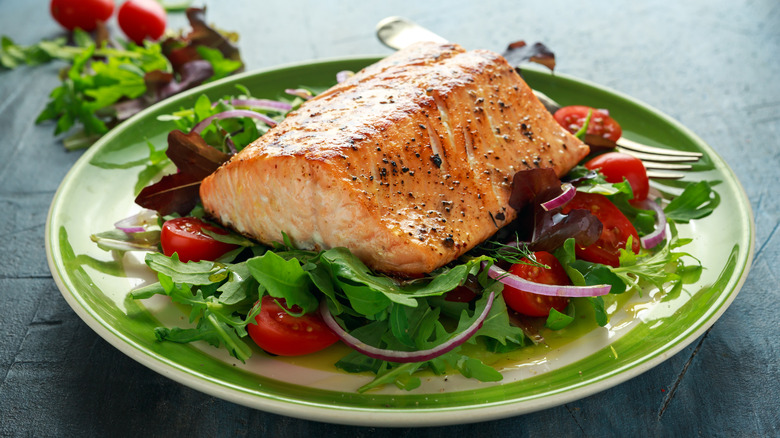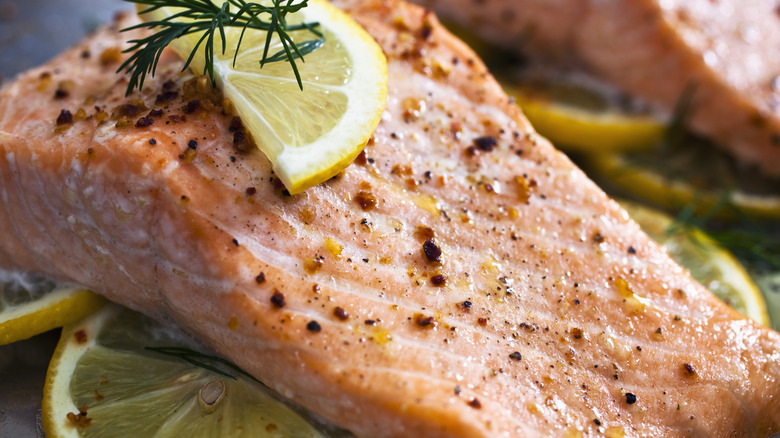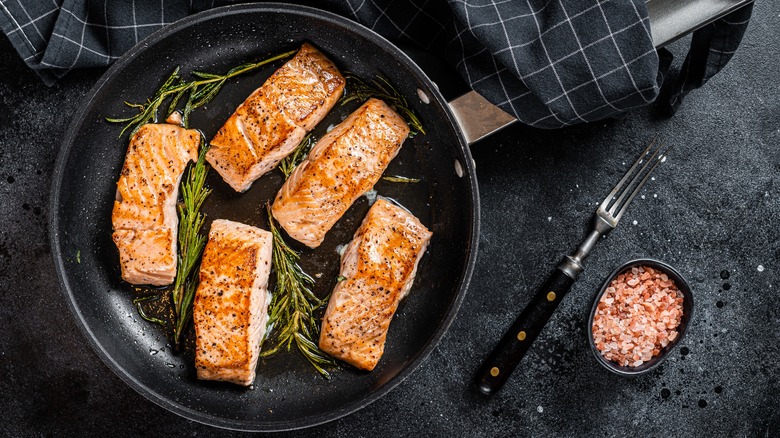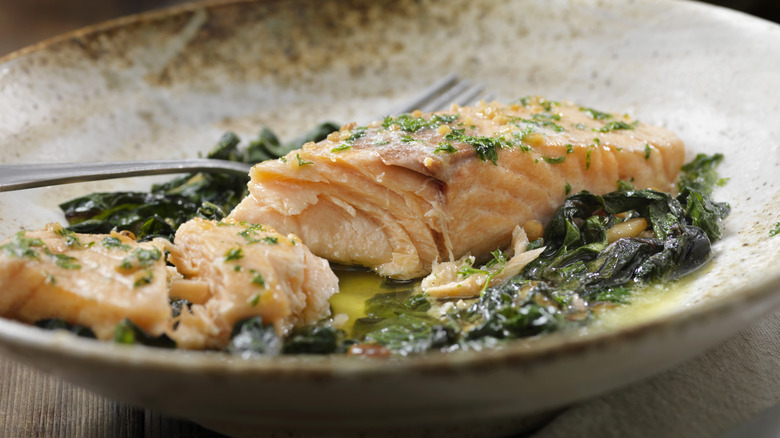13 Big Mistakes People Make When Cooking Salmon (And How To Avoid Them)
Salmon is one of the most commonly eaten proteins out there, but it can be uniquely tricky to cook. Salmon, like many types of fish, tends to cook way faster than meats like beef or chicken due to the flesh having shorter muscle fibers, and this can lead your filets to become overcooked or super-dry fast. In contrast to other types of meat, which are dense and remain so when being cooked, salmon also has a tendency to become flaky quickly, making the fish harder to handle. And while salmon is chock-full of flavor and juiciness thanks to its higher fat content, it can also be surprisingly bland when prepared incorrectly.
All of this can lead to your dinner becoming seriously unsatisfying — and this can sting all the more when you think about how much salmon can cost. While you can pick up frozen salmon for around $7 per pound, good-quality salmon will often be significantly more expensive, and the last thing you want is to waste money and time preparing a poorly cooked, tasteless meal. Luckily, many of the issues with cooking salmon can be avoided by becoming familiar with the main mistakes people make with this fish in the kitchen.
1. Forgetting to remove the pin bones
The majority of bones in salmon filets will be removed before they make it to the store, but pin bones are frequently still inside them. Pin bones are actually not bones at all (in fact, they're hardened nerve endings) but have the appearance and texture of small bones. Forgetting to remove them from your filets and leaving them inside increases the risk of you inadvertently eating one, which is, at best, unpleasant and, at worst, can cause irritation or lodging in the throat.
To prevent this from happening, you'll need to grab a pair of tweezers and pull them out — but you'll have to locate them first. Pin bones are small and can be hard to spot, so the best way to do this is to use clean hands to feel the surface of the filets, locating the pin bones before pulling them out. Don't try to pull them out vertically, as you'll rip through the flesh, and instead ease them out in the line of the bone. Make sure that your tweezers have been sterilized before use and that you clean them before you put them away.
2. Cooking with farmed salmon
Farmed salmon is incredibly common and is usually way cheaper than wild salmon. This ubiquity and low price have made it a popular choice amongst consumers. But farmed salmon is also problematic in several ways. Salmon farms can have a high impact on the environment, and they're also way less sustainable than other fish production methods, as wild fish are often caught and fed to farmed salmon. Farmed salmon are also often treated poorly due to being raised in cramped conditions and may contain chemicals that other salmon types do not.
Instead of opting for farmed salmon, you should always try to buy wild salmon wherever possible. Wild salmon tends to be better for you nutritionally, with a higher mineral content and lower overall fat, according to Healthline. Wild-caught salmon is also generally more sustainable, particularly if it's been caught in the U.S. or in Canada. Importantly, though, wild salmon is more expensive than farmed salmon, so it may not be a viable option all the time for people who have a stricter budget. If this is the case, try and find New Zealand-farmed Chinook salmon or Maine-farmed salmon, both of which are sustainable choices.
3. Cooking it before it's thawed properly
Like lots of other types of fish, salmon is awesome for freezing, and doing so can extend its lifespan for several months. When it comes to cooking it, though, don't be tempted to do so from frozen. Salmon cooks perfectly adequately straight out of the freezer, but doing so can alter its texture and cause it to seep out those white, stringy bits known as albumin. Cooking it from frozen can also make it way harder to flavor properly, and marinating a frozen salmon filet is somewhat pointless as the taste won't penetrate it properly.
You can avoid this by defrosting your salmon before cooking it. The simplest way to do so is to leave your frozen salmon filets in the fridge overnight, which will allow them to slowly thaw without getting too warm. Defrosting salmon in the fridge can take some time, though (larger pieces can take up to a full day before they're totally thawed), so if you need to speed things up, submerge your salmon in cold water. Make sure that it's wrapped tightly before doing so, and change the water periodically so that it doesn't warm up too much.
4. Seasoning your salmon too early
The right amount of seasoning can take a piece of salmon from merely average to totally showstopping. But it's easy to rush into things. Seasoning salmon too early can alter the texture of the fish, reducing its firmness and turning it soft. This is particularly a problem with salt-based seasonings or spice blends that contain sodium, as they pull the water content out of the salmon.
To prevent such an issue, make sure you're only seasoning your salmon just before you cook it. Rub any spice blends or salt onto your salmon just before placing it in the pan or in the oven. Some spices, like black pepper, may be better left off until after the salmon has cooked, especially if you're frying it at high heat. Black pepper has a tendency to burn easily, giving your fish an unappetizing flavor. Additionally, coarsely ground black pepper can create an uneven texture on the surface of the fish, which stops it from achieving its maximum contact with the pan. Chopped fresh herbs should also always be added at the end of the cooking process so that they don't burn or lose their flavor when the salmon is cooked.
5. Cooking it on the wrong side first
When salmon skin is cooked well, it's heaven: Crispy, fatty, and savory. But this can be ruined when you cook the wrong side first. If you pick the wrong side for your cooking method, the salmon skin will steam instead of crisping up, and all of the fat that usually makes it crunchy will instead become gelatinous and oily.
The side you should place it down on first depends entirely on which cooking method you're using. If you're frying salmon, you should always start skin-side down and keep it that way for the majority of the cooking process. This will give the skin the necessary amount of time to crisp properly and will save you from overcooking the salmon flesh if you try to do it the other way around. The same goes for if you're cooking the fish on a grill or a barbecue.
If you're baking, roasting, or broiling salmon, however, your salmon should be flipped. Cooking it skin-side up gives it constant contact with dry heat, which will allow the skin to get gradually crispy. It also means that the fat in the skin doesn't get trapped underneath the fish, pooling on your baking sheet, and instead melts and moistens the meat.
6. Using a cast-iron skillet
Cast-iron skillets are acclaimed for their ability to achieve and retain incredibly high heat, and this makes them ideal for searing meat and vegetables. But they're less useful for salmon. As with other types of fish, salmon flesh is flaky and separates easily, especially when it's started to be cooked. Cast-iron skillets that aren't thoroughly seasoned have a tendency to cause food to stick to them, and this means that more delicate items like fish are harder to flip. If you're unlucky, you'll end up with half of the filet glued to the pan.
Rather than have this happen, pick the right pan. Non-stick cookware is ideal for cooking salmon, as it can generally reach the heat necessary to get a good browning while also preventing any sticking. A seasoned stainless steel pan is also a good option. Seasoning will create a non-stick coating on the pan, and stainless steel cookware is generally very durable and capable of reaching high heat. Seasoned stainless steel is also a good option if you're looking to cook salmon in the oven.
7. Marinating salmon for too long
Marinating salmon is one of the best ways to ensure there's flavor in every bite. But while some meats need hours for marinades to permeate effectively, salmon needs less time than you think. Salmon flesh is pretty reactive to acid-based marinades, and these flavor mixtures have a habit of actually making the fish less flavorful and removing its natural moisture. Acidic marinades will also start to denature the proteins in the fish, essentially causing it to cook.
With salmon marinades, less is more. Ideally, you should marinate your salmon for no longer than 30 minutes. Salmon is less dense than chicken or beef, and there's greater separation between its proteins due to the structure of its connective tissue, which is why it becomes so flaky. This relative lack of density means that it can marinade properly in a shorter time.
To avoid feeling like you've wasted all your ingredients on such a short marination process, keep them to one side while you cook your fish. Then, use the leftover marinade to deglaze the pan, diluting it with a little water first to scrape up any leftover bits of fish. You'll end up with a rich pan sauce that you can then spoon over your filets before serving.
8. Always frying your salmon
Many people are creatures of habit, especially in the kitchen. This can lead us to stick to tried-and-tested recipes and cooking methods. But salmon is way more versatile than you think, and it doesn't always have to be fried. Baking salmon, for example, is an arguably easier method of cooking, which produces an arguably juicier result. As the salmon cooks more gently, it can hold onto its juices more effectively, and the slow cooking process gives it a more tender finish.
Opting to bake salmon instead of frying may also be a better choice nutritionally. Baked salmon generally takes less oil than fried salmon, especially if you're using a frying pan that doesn't have a non-stick surface. Using parchment paper to bake salmon can further take down the amount of fat required. If you really want to keep things low-fat, you can make parcels from parchment paper or foil, to steam your salmon while it bakes. Steaming salmon, as well as poaching it, may even make the fish healthier, as it allows it to keep hold of its nutrients better.
Remember, though, that these cooking methods likely won't produce the same flavors as frying will. High-heat searing produces a brown, flavorful crust, which baking or steaming just can't replicate.
9. Poking it too much
If you're a prodder, we can relate. Poking and fiddling with our food while it cooks is endlessly satisfying and can allow us to check its texture and assess whether it's done yet. But with salmon, poking it too much while it cooks can ruin it. Over-handling salmon, or any fish, while it cooks can loosen its structure, and if you prod it too hard, you can start to separate the flesh. This will result in all of those delicious juices leaking out and into the pan, leaving the fish dry and mealy.
But the solution is pleasingly simple: You just have to leave it alone. Once your fish is in the pan, don't touch it until the time your recipe states has passed. The only time you should touch your fish is to flip it over. If you're worried about the fish adhering to the pan if you're not constantly touching it, remember that the opposite is actually true. When your fish has browned enough, it will free itself from the pan, allowing you to flip it. Moving it around too much, though, will prevent it from searing properly.
10. Overcooking it
One of the cardinal sins of making salmon is overcooking it — and it's one that a lot of people commit. Salmon is incredibly easy to overcook, as it cooks so quickly compared to other types of meat. This is especially true of wild salmon. As wild salmon has a lower fat content than farmed salmon, it can not only cook quicker, but it also gets dry very fast as there's less fat to lubricate it.
Overcooked salmon will start to look overly pale in appearance, losing its rosy pinkness. It will also become way too flaky and start to fall apart. You should take your salmon off the heat when it feels firm to the touch, is just beginning to flake apart, and still retains its color.
Try not to be tempted, though, to remove salmon from the heat too early. Undercooked salmon is not just unpleasant to eat, but it can also pose a safety hazard, as certain bacteria that cause food poisoning may not have been killed off with sufficient heat. Make sure that no part of the salmon remains translucent or that it doesn't feel too soft to the touch.
11. Forgetting to leave salmon to rest
Resting meat is a crucial part of cooking it. When you cook animal protein, it begins to constrict, pushing any moisture inside it out to the surface. Resting meat after cooking allows this moisture to re-incorporate with the meat, stopping it from being dry when you cut into it.
Most fish, however, don't need resting, as they usually have a lower moisture and fat content than meat. But salmon is different. Salmon's high-fat levels make resting it crucial, and resting it has the same effect as resting a piece of meat, allowing the juices to seep back into the flesh.
To get the best result, cook your salmon for the time specified in your recipe, and then remove it from the heat, allowing it to rest for several minutes. If you want to keep it warm while you do this, cover your filets with tin foil or place it under a plate. Ideally, your salmon should reach an internal temperature of 145 degrees Fahrenheit before you take it off the heat, to ensure that it's cooked all the way through.
12. Poaching it in water
People often forget about poaching salmon as a cooking method, but it's one of the best ways to prepare it. Salmon is a delicate fish, and cooking it using the low temperature of poaching liquid allows it to retain its structure while cooking gently, keeping it juicy. Poaching is also an extremely healthy way of cooking salmon and is a great choice for people who want to do so without using additional fat.
The main mistake people make, though, is using just water to poach it. Using plain water will add no flavor, and it can leave the fish totally tasteless. The best thing to do is create a tasty broth or stock to add to your salmon. Fish stock can be a great base liquid to which you can add extra flavorings like onions, garlic, a bundle of herbs, or slices of lemon and orange. Using a dairy-based broth like milk can also add flavor while simultaneously giving the fish a creamy edge.
When poaching, temperature and time are key. The water should never boil and shouldn't even simmer. Keeping it at around 140 degrees Fahrenheit is optimal. Most salmon filets will poach in around 10 minutes — make sure to give them the full length of time to avoid them being undercooked in the middle.
13. Using the same seasonings
In the middle of a busy working week, it can be hard to be creative with our meals. This can lead people to fall back on the same old recipes for things like salmon. But as the fish is incredibly versatile, using the same seasonings again and again can be a missed opportunity to take advantage of a different aspect of the fish's natural flavor profile. For example, the sharp notes of whisky and ginger can work to contrast against the salty, brinier notes of the fish, especially in grilled salmon recipes. A sweet-and-spicy take on salmon, meanwhile, by using curry powder and chopped mango, can help to lift the savory notes.
You should also try to adjust your salmon seasoning for baking vs. grilling. Using certain seasonings with the high heat of a grill, like sugar or honey, can cause them to burn, ruining the flavor of your fish. Powdered spices can also burn at high temperatures, especially if they're patted on dry with no additional oil. Baked salmon, meanwhile, benefits from slightly more delicate flavors, as the more gradual cooking process means that it won't kill them off or burn them.
